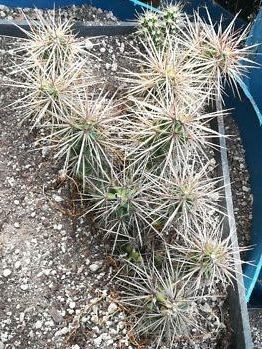Cursed Cholla
(Grusonia emoryi)

Description
Grusonia emoryi is a species of plant in the genus Grusonia ofthe cactus family (Cactaceae). The specific epithet emoryi honors the American Major William Hemsley Emory who was responsible for surveying the Mexican border from 1850 to 1854. Common names are "Cursed Cholla" and "Devil Cholla". Grusonia emoryi grows low and forms richly branched mats 15 to 30 centimeters high. The roots are fibrous. The curved, club-shaped shoot sections that gradually or abruptly narrow towards their base are 7 to 19 centimeters long and have a diameter of 2.5 to 5 centimeters. They are covered with conspicuous humps that are 2 to 5 centimeters long. The circular areoles are covered with white to gray wool and yellow to brown glochids that are 5 to 7 millimeters long. The yellow, reddish brown or ocher spread spinesare regularly distributed over the shoots or are located only on the areoles near the tips of the shoots. The upper three to five spines, sometimes only a single one is present, are ascending, spreading and angular to flattened to almost twisted. The lower three to five spines are spreading and sharp-edged to flattened. The yellow flowers reach lengths of 2 to 3 centimeters. The cylindrical to ellipsoidal, yellow fruits are fleshy and covered with dense yellow glochids. They are 4 to 9 centimeters long and have a diameter of 1.4 to 4 centimeters. Grusonia emoryi is distributed in the United States in southeastern Arizona, southwestern New Mexico, and southern Texas and in the Mexican state of Chihuahua in the vegetation of the Chihuahuanian Desert at elevations of 900 to 1220 meters. The first description as Opuntia emoryi was in 1856 by George Engelmann. Donald John Pinkava placed the species in the genus Grusonia in 1999. Other nomenclatural synonyms are Cactus emoryi (Engelm.) Lem. (1868) and Corynopuntia emoryi (Engelm.) MPGriff (2003). In the IUCN Red List of Threatened Species, the species is listed as "Least Concern (LC)". H. listed as not endangered. The development of the populations is considered to be stable. The plants are either short-cylindrical and form groups or shrubby or tree-like. The roots are usually turnip-like, but sometimes fibrous. The shoots are usually divided into cylindrical to spherical segments, which sometimes have bumpy ribs. Hair, spines and glochids arise from the areoles. The pink, purple, yellow or white flowers appear laterally or almost at the top of the shoot and open during the day.
Taxonomic tree:







